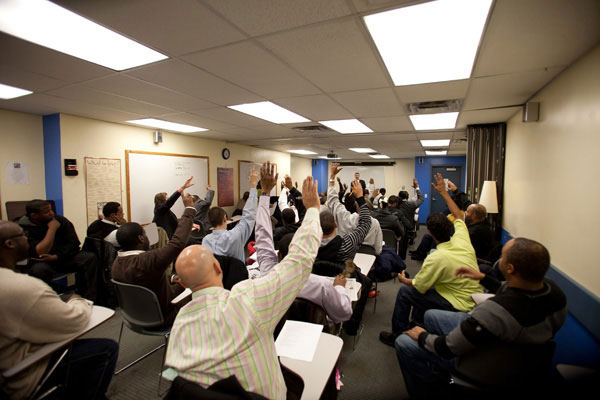
Photo by: Colin Lenton
Clients at a Harlem job training service in March. The sharp upturn in unemployment during the recession has increased poverty, more so among Latinos and blacks than among whites.
The recession pushed more than 6 million Americans into poverty and sent the national poverty rate to its highest level in 16 years, the Census Bureau reported Thursday.
The increase in poverty during the recent downturn was worse than in four shallower recessions of the past 40 years. But the 2007-2009 recession’s impact on poverty was less than the similarly deep recession of the early 1980s, a development for which the federal stimulus bill might deserve credit.
The national poverty rate rose from 13.2 percent in 2008 to 14.3 percent in 2009, the highest it has been since 1994. Latinos suffered the highest increase, from 23.3 percent to 25.3 percent. Black Americans saw a 1.1 percentage point increase in the poverty rate and non-Hispanic whites experienced a smaller increase.
The 43.6 million people living in poverty in 2009 was the highest number recorded in the 51 years that the government has tracked poverty, but the 2009 poverty rate was 8 percentage points lower than 1959, the year in which the highest rate was recorded.
New York State’s two-year average poverty rate rose from 14.3 percent in 2006-2007 to 15 percent in 2008-2009—the 16th highest rate among states (Mississippi, with 20.6 percent poverty, posted the nation’s worst rate). Thirty-two states saw bigger increases in their poverty rates than New York, with Arizona’s 5.2 percent increase leading the nation.
In a comparison of the impact of recessions on poverty in the country, the Census Bureau found the December 2007 downturn has been significantly more painful than the recessions starting in 1969, 1973, 1990 or 2001. Since ’07, the poverty rate has leapt 1.9 percentage points and 6.3 million people entered poverty.
But in the only comparable recession—the longer 1980 to 1982 downturn—the rate increased by 3.2 percentage points and some 10.8 million people slipped below the poverty line.
Last year, researchers at the Center on Budget and Policy Priorities found that the 2009 federal stimulus package helped keep 6 million people out of poverty.
The Census Bureau also reported Thursday that the number of people without health insurance increased from 46.3 million in 2008 to 50.7 million in 2009.
Thursday’s release did not detail poverty rates for local areas. Those numbers are due out September 28th.







